An evening with Ms Asha Batra
About Ms Asha Batra
On Friday, August 4, we had a very engaging session by Ms Asha Batra, the Founder Trustee of Indian Cinema Heritage Foundation. This is a not for profit public charitable trust set up to chronicle and archive the rich history of Indian cinema. The Foundation houses the largest private collection of Indian cinema memorabilia and literature. That includes film booklets, lobby cards, showcards, film posters, hoardings, pamphlets, magazines, newspapers and books, film projectors, editing machines, music and much more.
Ms Batra spoke about the Indian movie industry and how she is trying to archive all the rich material which is currently lying fragmented and inaccessible to the public.
Ms Batra, a lawyer by profession and a film enthusiast, has created a huge database on people, films, stills and publicity materials. She is actively involved in creating the content and visibility in the social media of Cinemaazi, the brand name for the initiative.
To maintain the credibility of the work done, Ms Batra is hands on. She does first hand research by watching the films herself, by reading archival material from the Foundation’s library and talking to film scholars and film historians.
Ms Batra is also the director of Kumaon Literary Festival – a traveling literature festival.
As managers we should strive to build our direct reports so that they move up and beyond our team. In the process, we may lose some good people. But the benefits are many:
Cinemaazi is the first of its kind enterprise to develop a digital repository and encyclopaedic resource to:
- We will have better employees working for us or for a different organization.
- Chronicle and preserve the rich history and heritage of Hindi, and other regional cinemas.
- Document the extra-ordinary legacies of people and archive their rich contribution.
- Exhibit the exquisite and colourful cinema memorabilia from the in-house collection of the founders.
- Recount the spectacular journey of Indian cinema and its people, through digital content in multimedia format.
- Rekindle memories and create nostalgia.
Till date, Cinemaazi has documented over 8000 films (Hindi, Punjabi, Tamil, Telugu, Konkani and others) and profiled more than 900 persons associated with cinema. Cinemaazi is paying a lot of attention to the contribution of lesser-known people to Indian cinema and is giving them their due.
Cinemaazi’s YouTube channel hosts over 120 episodes under various playlists. The contents of Cinemaazi TV are available on the channel.
The Oral Memory Project of the Foundation involves interviews with surviving family members of people from the film fraternity, fans and people associated with less well-known artists and technicians who made immense contributions to the Indian film industry.
How Cinemaazi was conceived
Indian Cinema occupies the centre-stage of the life of an average Indian as a means of entertainment. It has a rich heritage and history. Many people and institutions have contributed to its development. But the content on vintage cinema is fragmented across many portals on the Internet or buried in the material resting with the private collectors. Information available in the public domain is not always reliable.
Ms Batra and her husband, Sumant are avid film lovers. They have built a vast collection of Indian cinema memorabilia and other informative content over the years. Recognising the need for a single, comprehensive, accessible, and reliable resource on the Indian cinema, they decided to curate this content. Gradually, the scope and scale of their work have expanded.
About the team and the work
Cinemaazi aspires to chronicle over 35,000 films made in Hindi, Assamese, Bengali, Gujarati, Garhwali, Kannada, Konkani, Malayalam, Manipuri, Marathi, Punjabi, Tamil, Telugu and other regional languages, from 1913 t0 1999. Currently, the period up to the early 1980s is being covered. Over 2000 persons are being profiled.
In view of the huge task involved, chronicling is being done in phases. Due to the sheer magnitude of the project, the curation of content on the website will always be a work in progress.
Ms Batra has a team of 6-7 people who do the digitizing, scanning and research work. In areas like the south, Punjab and Bengal, local people have been commissioned for the project.
These are early days and it is still work in progress. Archival of Konkani movies has been completed because the numbers are relatively small. But when it comes to Hindi movies, a lot remains to be done.
Magazines do not focus on the less well-known people. So the personal details of these people, how they entered the industry and so on are not easily available. There are many people with the same name. This makes the work all the more challenging.
During the Q&A, Ms Batra admitted that the industry is generally closed and not willing to part with any content for free. There are some exceptions. Actor Hiralal Thakur’s son has provided a lot of information. The Cinemaazi team has also tried to tap the knowledge of people not directly connected to the industry. Board members have helped.
About the Indian film industry
India makes the largest number of films in the world. India produces films in 41 languages highest being Hindi, Tamil, Telugu, Kannada, Marathi and Malayalam. Not surprisingly, India is the global leader in terms of linguistic diversity.
In 2022, Indian cinema earned ₹15,000 crores at the box-office. Overseas Indians account for 12% of revenue for the industry. Indian Cinema has the largest viewership in countries like Middle East, Africa, South Asia, India, Pakistan, and the US.
The importance of teamwork
A movie is not just about the stars. Making a movie requires art, technology, and money. It involves the director, producer, cinematographers, art directors, music composers, poster artists, technicians, arrangers, and various assistants. We only remember the stars in front of the camera. But there are many others behind the camera who make a film possible. After providing a brief history of the evolution of Indian cinema, Ms Batra spoke about some of these less well-known personalities.
A short history
Following the screening of moving pictures in London in 1896, commercial cinema became a worldwide sensation. These films were shown in Bombay that same year at the time of the great famine. There was a phenomenal response from the public despite the high price of the ticket. Due to the overwhelming response, the 2-day trip made by the exhibitors to India became one month long.
Dadasaheb Phalke
DG Phalke is widely considered the father of Indian movies. In 1913, Mr Phalke released Raja Harishchandra (1913) in Bombay, the first film made in India. It was a silent film incorporating Marathi and English intertitles.
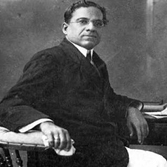
Baburao Painter
Compared to Mr Phalke, Baburao Krishnarao Mestry, popularly known as Baburao Painter (1890 –1954) was not so well known. But his contribution to the Indian film industry was also outstanding. He was a man of many talents with proficiency in film production, painting, sculpture, photography, and mechanical engineering.

When we think of cinema, we immediately think of the projector. Baburao felt that he could make a camera from the projector. It required two years to build the camera by doing many experiments on a lathe machine.
Sairandhari (Draupadi during exile) was a 1920 Indian film Baburao directed, based on an episode from the Mahabharata. It was produced by the Maharashtra Film Company. V. Shantaram remade it as Sairandhri in 1933. The depiction was so real that in the movie theatres, people would scream out of fear.
Baburao was also a great teacher. He trained many technicians (250-300). He pioneered the fade in fade out effects which are important during transitions. Looking back, he was clearly ahead of his time.
Master Nisar
Master Nisar (Nissar Ali Mohammed Ali) was the most popular hero of the early talkie films. He could sing and had a good memory, an important quality for remembering dialogues. He was also one of the most highly paid stars of that era. Once a large crowd gathered to see him. The Governor of Bengal was forced to divert his car to another road! He worked in 75 films.
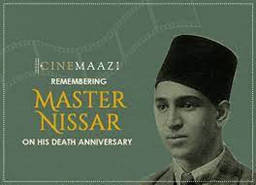
After 1947, Nisar’s career went into decline. Having enjoyed fame, name, money, and fan following once, he had to spend his last days in misery, poverty, neglect and pitiable conditions in a one room tenement in a Kamathipura chawl. During his heydays, he had learnt the art of massaging, as a hobby. In his last days, he used to work as a masseur and earn a few rupees sometimes.
Poster Artists
Prithvi Soni
Poster artists have never received the credit they deserve. Prithvi Soni was one of them. Soni had a passion for painting from the very beginning. In 1965 he learnt painting at Rang Roop Studio, in Andhra Pradesh. With his creativity and artistic bent of mind, he started to paint the posters of artists like Dilip Kumar, Amitabh Bachchan, Raj Kumar and Dharmendra as a hobby. It was Raj Kapoor who gave him the break with assignment of painting the posters of Sangam. This was followed by more and more assignments. He became one of the most sought-after painters amongst the producers, distributors, and exhibitors.

Madhukar Kher
Madhukar made posters for landmark movies like Mughal E Azam and Razia Sultana. Know more about Madhukar from this video:
https://www.cinemaazi.com/cinema-memory-project/cinema-memory-project-madhukar-indian-cinema
Arrangers
Sebastian D Souza
Arrangers are an integral part of music. They help finish and adapt preexisting compositions by altering the instrumentation, orchestration, harmony, tempo, and genre.
Sebastian D'Souza (1906-1998) was a Goan music arranger who mastered the art of fusing Indian music with European classical music concepts. He was largely responsible for changing the entire harmonic structure of the Hindi film song to create memorable songs. D’Souza pioneered counter melody which became popular from 1950 onwards. He became the most wanted music arranger of many music directors of Hindi Film industry. From 1951 till 1975, he was a permanent assistant to the famous music composers, Shankar Jaikishan. Songs like Ae Maalik Tere Bande Hum and Ajib Daastan Hai Yeh are a testimony to the creativity of his work.
https://www.youtube.com/watch?v=AU-hut9lGQ4
During the Q&A, Ms Batra mentioned that Goan musicians have made a big contribution to melody. Their association with the church and familiarity with church music has played a big role. They have tried to combine the best of western and Indian music. It is through such churn that the art progresses.
Manohari Singh
Manohari Singh (1931 –2010), a Nepali by origin, was a saxophonist and the main arranger of the famous music composer RD Burman. He also worked with Basudeb Chakraborty as a music composer. The duo was popularly known as Basu-Manohari. His first break was in 1958 with S D Burman as a saxophonist for the movie Sitaron Se Aage. Manohari played on the hit "Gaata Rahe Mera Dil", composed by SD Burman in the movie Guide. He also played for songs in the movies Chalte Chalte and Veer Zaara. He (as Basu-Manohari) composed the music for Sabse Bada Rupaiya, produced by Mehmood, starring Vinod Mehra and Moushumi Chatterji.
https://www.youtube.com/watch?v=ayi7A7LK2sQ
https://www.youtube.com/watch?v=KlniHtzFgb0
Music composers
Biddu Appaiah (born 1944) has composed and produced many worldwide hit records during a career spanning five decades. He began his music career in the 1960s, singing for a music band in India. He then moved to England to start his career as a producer. Following the decline of disco in the Western world, Biddu found success in Asia during the 1980s.
In the late 1970s, Western disco was getting popular in Asia and particularly in India. In 1979, Feroz Khan wanted to introduce a catchy song in his upcoming Hindi film, Qurbani. (The main score of the film was by the Indian music duo, Kalyanji Anandji.) Biddu was initially not interested but he took it up to keep his mother in India happy.
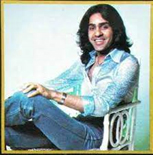
About the same time, Khan happened to come across 15-year-old Nazia Hassan at a party in London. Khan later requested Hassan to have an audition with Biddu. It did not take long for Biddu to compose Aap Jaisa Koi for Qurbani. The song was recorded in London. In 1980, Qurbani ran to packed houses in India, largely on the weight of this song and another number "Laila O Laila". Nazia Hassan became a teenage sensation. "Aap Jaisa Koi" was a hit across the Indian subcontinent.
https://www.youtube.com/watch?v=B01v29_qORc
Biddu also produced the debut album Disco Deewane of Nazia and her brother Zoheb, which charted in fourteen countries and became the best-selling Asian pop album up until that time.
Cinematographers
Subrata Mitra
Subrata Mitra (12 October 1930 – 7 December 2001) was an Indian cinematographer, acclaimed for his work in Satyajit Ray’s Apu trilogy (1955–1959, Pather Panchali, Apur Sansar and Aparajito), Mitra was a technical genius.
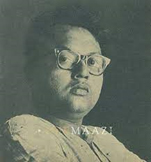
Mitra made his first innovation while shooting Aparajito. The fear of heavy rains had forced the art director, Bansi Chandragupta to abandon his original plan to build the inner courtyard of a typical Benares house in the open. The set was built inside a studio in Calcutta. Mitra argued in vain with both Chandragupta and Satyajit Ray about the impossibilities of simulating shadowless diffused skylight. But this led him to innovate and come up with his most important tool, bounce lighting. Mitra placed a framed painter white cloth over the set resembling a patch of sky and arranged studio lights below to bounce off the fake sky.
https://www.youtube.com/watch?v=a7jLh_nMI8w
The Ray-Mitra partnership resulted in many unforgettable classics: Paras Pathar (1958), Apur Sansar (1959), Devi (1960), Kanchenjungha (1962), Charulata (1964) and Nayak (1966). Mitra shifted to colour in Kanchenjungha, approaching it with the same intrepid determination as he had done in Pather Panchali. The film only consumed 29 rolls of colour negative whereas an average Hindi film would take up to 350 rolls.Art Directors
Sudhendu Roy
Sudhendu Roy (1921–1999) was best known for his realistic art direction in Bimal Roy’s films, like Sujata (1959), Madhumati (1959) and Bandini (1963). He won the Filmfare award for best art direction thrice for Madhumati (1959), Mere Mehboob (1964) and Sagina (1975).
https://www.cinemaazi.com/video/art-direction-of-sudhendu-roy-1
Roy received his first opportunity to independently direct a film for Rajshri Productions with Uphaar (1971). The movie was inspired by Rabindranath Tagore’s short story titled Sampati. He also worked in Subhash Ghai’s Karz (1980) and Karma (1986) and Yash Chopra’s Silsila (1981), Chandni (1989) and Lamhe (1991).
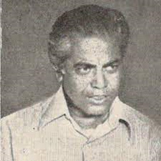
A reclusive man, Roy kept to himself and his close friends, one of whom was the actor Abhi Bhattacharya. Roy was known to listen closely to the director’s descriptions and come up with innovative sets like the turntable set for the song Om Shanti Om in Karz (1980).
Roy also trained other art directors like Desh Mukherjee, R. Verman as well as his daughter Sharmistha Roy. He passed away in 1999.
Writers
Writers are an integral part of Indian cinema. The Progressive Writers’ Movement (PWM) was a literary and cultural movement in India that emerged in the 1930s and gained prominence in the 1940s. The PWM sought to use literature as a means of promoting social and political change. The movement wanted to address the challenges of the day, such as poverty, inequality, and oppression.
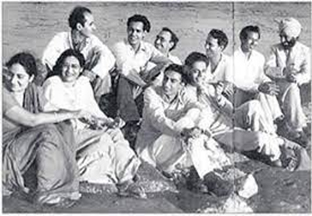
Several Urdu writers came to Bombay all through the 1940s to find work in the film industry — as scriptwriters, lyricists, film journalists — and met with varying degrees of success. By the time World War II ended, some of the most dynamic writers of the age had arrived in Bombay from different parts of undivided India.
Ms Batra mentioned the names of:
- Sahir Ludhianvi
- Jan Nisar Akhtar
- Krishan Chander
- Balraj Sahni ( IPTA)
- Salil Chowdhury
- Rajinder Singh Bedi
Dancers
Helen and Madhumati
Helen is well known. But another talented dancer, Madhumati is not so well known. (In the picture below, Helen is on the left and Madhumati on the right.)
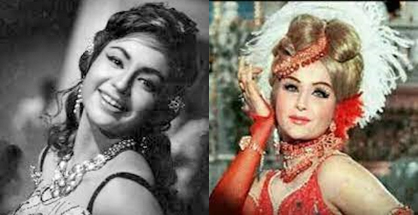
Born in 1938 in a remote village near Maharashtra, Madhumati made her debut as a dancer in 1957 in an unreleased Marathi movie. Later, Madhumati also featured in Punjabi, Hindi, Bhojpuri and South Indian movies. She was often compared to Helen in terms of her dancing abilities and looks. She made her exit in 1977 and made a comeback in 2001. After her husband passed away in 2002, she began to focus on running the Madhumati dance academy in Mumbai.
Villains
Pran and Hiralal Thakur
Pran is well known. But Hiralal Thakur (1909-1981), is not so well known.
Hiralal was called the 'bad man of the Indian screen' for his portrayal of roles with negative shades. He took part in India's independence movement and became an activist with the Indian National Congress when he was 14. He was later associated with a group of political and social workers that included Lala Lajpat Rai and Bhagat Singh, before moving into a career in films. Hiralal made his debut with the silent film Safdar Jung (1930). After a distinguished career in films for over 50 years which included at least 150 films, he died penniless in 1981. (In the picture below, Pran is on the left and Hiralal on the right.)
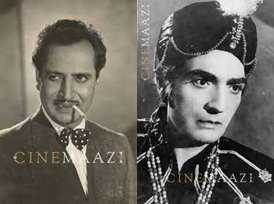
Lesser known artists
We would not recognize the name Chand Burke. But she was the grandmother of Ranbir Singh.
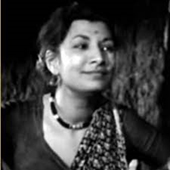
The not so well-known Arun Ahuja was the father of Govinda.
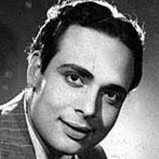
Little known Ratna Shethy is the mother of Rohit Shethy.
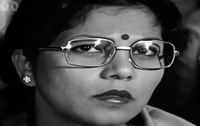
Sometimes, we must raise the profile of less well-known people by relating them to better known ones.
Why archiving?
Movie films are highly perishable and also inflammable. Data gets lost when the medium changes. So it needs to be changed to the new medium.
Q&A
Ms Batra grew up in a small town in the northeast. She did not have access to Hindi movies. Her husband Sumant is also a film enthusiast and has always been a collector. Ms Asha has sought to give meaning to this collection. Ms Batra would see old things being discarded or sold at thrown away prices to kabadiwallas (waste pickers). She was disappointed to see history getting eroded this way. Why not preserve it and give it back to society? Archival became even more important because when the medium changes, a lot of data gets washed away. Moreover, culturally, we Indians are not good at archiving. So she began to collect all kinds of items including typewriters, tape recorders and printing machines.
Ms Batra feels that as a woman and mother, multi tasking comes naturally to her. She has used her time effectively to do many things in life. She has always believed in creating a niche for herself by doing work which others cannot understand. Ms Batra feels it is important to have both a telescopic (big picture) and microscopic (details) view of any work we do. She has also understood the importance of connecting the dots.
The message from Ms Batra is that we must be proud of our heritage. We must also give back to society. Sharing of knowledge is good for society. Any knowledge should be made available in the newest medium so that young people start taking interest.
We must do work close to our heart. We must totally believe in it and work with passion. Archiving is boring work. It is not glamorous. Without passion, we cannot do it. To succeed in our endeavours, we must have a purpose, a cause to help others. When we have a cause, we feel more energised to do our work.
Cinemaazi encourages publication of papers. It supports the research work of PhD students. Cinemaazi also has plans to launch courses. Cinemaazi also organizes small retreats and public talks.
After the pandemic, two distinct segments have emerged for OTT and theatre. OTT and theatre will coexist. Movies like Bahubali can be watched only in theatre.
Children movies will be showcased separately by Cinemaazi.
